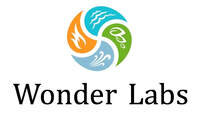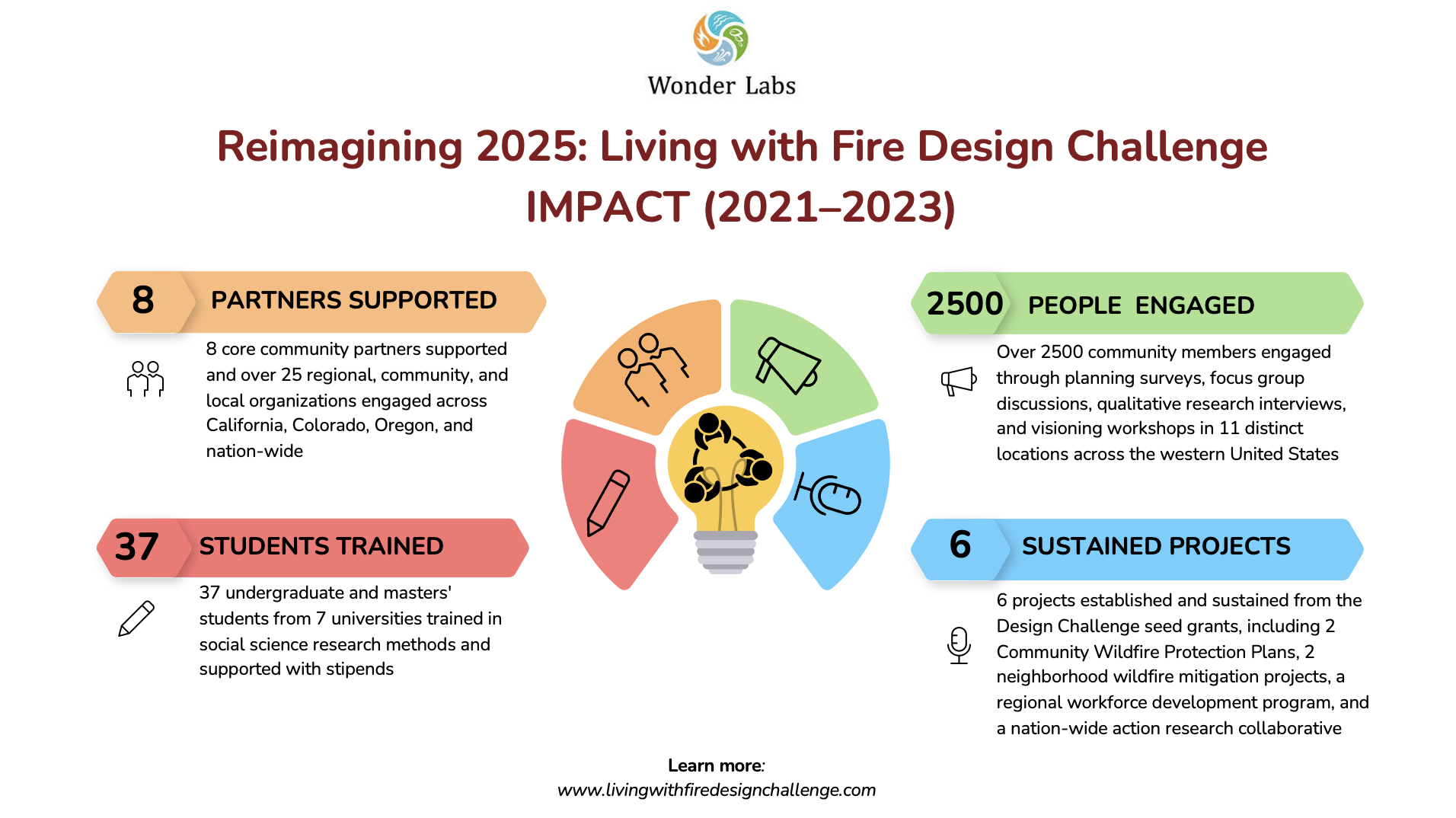Reimagining 2025:
Living with Fire Design Challenge
About
Wonder Labs is a social enterprise based in San Jose, California. Our mission is to catalyze social and ecological innovations with communities on the frontline of climate impacts. We do this by co-developing technologies, facilitating convergence research, and granting seed capital for community-led innovations. Our work is guided by the United Nation’s Agenda 2030, the Sustainable Development Goals, and the Sendai Framework for Disaster Risk Reduction 2015-2030. Our five-year mission is to reduce catastrophic wildfire risk for diverse communities across the American West. Through our Reimagining 2025: Living with Fire program, we advocate for a ‘Policy, People, Places’ approach to wildfire risk reduction.
AIM
Wonder Labs created the Reimagining 2025: Living with Fire Design Challenge to center the voices of students and emerging scholars in current discussions on wildfire risk management. Launched in 2021, the Living with Fire Design Challenge enabled student-led teams to closely engage with communities in processes of reimagining inclusive, just, and equitable pathways to living with fire.
AWARDS
Over three years and two cohorts (2021 and 2022-2023), the Living with Fire Design Challenge supported seven teams in conducting reimagining exercises with communities across California, Colorado, Oregon, and nation-wide. The projects were completed over a period of 6–12 months. The teams consisted of at least three students, one faculty advisor, and one community partner. Each team received an award of up to USD $20,000, access to a highly experienced mentor network, and pathways to further opportunities.
METHOD
Based in futures-thinking, the objective of the Design Challenge was to enable student-led teams to closely engage with communities in processes of reimagining inclusive, just, and equitable pathways to living with fire. Projects were co-developed with communities at high risk of wildfire impacts. All teams facilitated community-led structural analysis and scenario building to identify reimagined pathways to living with fire. Projects reflected on values, amenities, social and environmental justice goals, with due attention to other locally relevant issues. Outputs included an identification of ‘projected state/s’ and ‘reimagined state/s’ of living with fire.
A ‘projected state’ can be defined as a ‘business as usual’ scenario based on the current trajectory of wildfire risk reduction efforts in a community. In contrast, a ‘reimagined state’ can be defined as a process of reimagining ideal or desirable future/s by collaboratively envisioning diverse new possibilities. A ‘projected state’ can help forecast how we will live with fire in 2025 if we continue to do what we’re doing right now or do more of the same. A ‘reimagined state’ can enable a community to back cast how to get to reimagined future state/s by choosing new pathways, sometimes building on.
Project teams developed ‘projected state/s’ and ‘reimagined state/s’ of living with fire using indicators, maps, graphs, and other visualization tools. It is expected these outputs will contribute to a more robust characterization of fire adapted communities across social geographies, while highlighting diverse pathways to get there.
FIRST COHORT
In 2021, our first cohort of teams co-developed designs with community partners in four communities across California and Colorado. These student-led interdisciplinary teams pursued bold ideas to reimagine how communities can live with fire in Ventura County, Santa Barbara County, Marin County in California and Boulder County, Colorado. See Teams to learn about key outcomes.
SECOND COHORT
Building on the success and lessons learned from the first cohort (2021), our second cohort (2022-2023) focused on reimagining forestry and fire workforce capacities for inclusive, equitable, and just outcomes through: engaging youth in Community Wildfire Protection Plans in Nederland, Colorado; developing forestry and fire career pathways for justice-impacted people in the Bay Area, California; and engaging and partnering with diverse young people to contribute to fire governance across the United States.
Learn more about these projects and outcomes on the Teams page!
IMPACT
The Living with Fire Design Challenge achieved the following impact across two cohorts:
8 core community partners supported and over 25 regional, community, and local organizations engaged across California, Colorado, Oregon, and nation-wide
37 undergraduate and masters students from 7 universities trained in social science research methods and supported with stipends
Over 2500 community members engaged through planning surveys, focus group discussions, qualitative research interviews, and visioning workshops in 11 distinct locations across the western United States
6 projects established and sustained from the Design Challenge seed grants, including 2 Community Wildfire Protection Plans, 2 neighborhood wildfire mitigation projects, a regional workforce development program, and a nation-wide action research collaborative
FUTURE DIRECTIONS
Read Wonder Labs' call for a new research and practice agenda to reimagine the forestry and fire workforce in caring, equitable, and just ways here.
See call for research submissions to the Fire Journal's Special Issue on 'Reimagining the future of living and working with fire', here.
Finally, read Wonder Labs’ recommendation to the Federal Wildland Fire Mitigation and Management Commission to Invest in worker-led industries for whole of community wildfire resilience, submitted through the Federation of American Scientists’ Wildland Fire Policy Accelerator.
Founders
The Living with Fire Design Challenge was created by Wonder Labs’ co-founders, Shefali Juneja Lakhina and Anukool Lakhina, to enable more impactful and inclusive convergence research with communities learning to live with fire. You can learn more about Shefali and Anukool’s background here: https://www.wonder-labs.org/founders.html.

